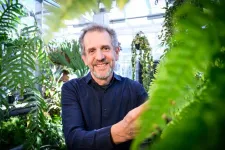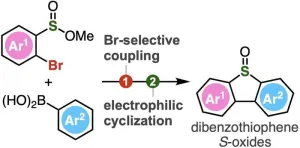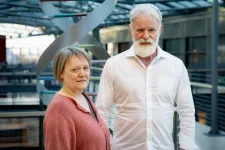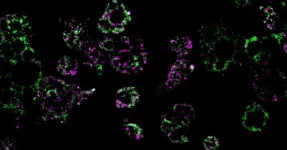(Press-News.org) INDIANAPOLIS -- Approximately four of five primary care clinicians consider themselves on the front lines of brain health. In the U.S., clinicians are the first point of contact for patients worried about memory loss and are most likely the first to detect and evaluate patients experiencing mild cognitive impairment, Alzheimer’s disease or related dementias.
In a new study focused on understanding the barriers of clinician-patient conversations about brain health and cognitive concerns, Regenstrief Institute and Indiana University School of Medicine Research Scientist Malaz Boustani, M.D., MPH, found that early conversations about brain health between clinicians and their patients are rare due to the stigma around an Alzheimer’s disease or related dementia diagnosis.
“Similar to the HIV/AIDS epidemic in the 1980s or the public fear of cancer in the 1970s, Alzheimer’s disease and related dementia diagnoses are stigmatized,” said Dr. Boustani, senior author of the study. “We are looking at past stigmas and how we can leverage the current day information technology opportunity to develop tools, processes and strategies to create a demand for the brain health conversation in primary care and destigmatize the Alzheimer’s disease and related dementia diagnosis.
“The stigma around Alzheimer’s disease and related dementias creates a barrier between clinicians and patients causing the lack of conversation about brain health or cognitive concerns. To create the necessary and potentially effective tools, processes and strategies, we must move past the stigma that surrounds having a brain health or cognitive concern conversation,” said Dr. Boustani.
Findings from the study also revealed that:
both clinicians and patients are hesitant to initiate these conversations,
evidence to inform brain health interventions is often poorly communicated and
social and cultural factors impact clinical engagement between primary care clinicians and their patients.
The study suggests that when cognitive impairment is suspected, the language and approach to the conversation between physician and patient for brain health or a cognitive concern should be tailored to the patient’s social and cultural context.
For example, a nurse-led, faith-based, culturally tailored educational program about Alzheimer’s disease, related dementia and early detection has generally been positively received by members of the Black community. Although this education is provided in a group setting instead of in an individual encounter, the culturally relevant messaging developed as part of these programs can serve as a guide to have a brain health conversation for physicians. This point is particularly important given how stigma and sociocultural differences can negatively impact health-seeking behaviors related to cognitive concerns and discourage inclusion in clinical research and advances in clinical care.
“Having a conversation about your brain health when you go and see your provider, who is responsible for your health overall, should be a normal occurrence,” said Dr. Boustani. “Why would you have a conversation about your kidney or liver, your heart, your lung, your muscle, your bone and not have the conversation about your brain, which is the most prestigious or precious organ and the one that you don't have a chance to regain if you lose it?”
The researchers also identified the Agile Diffusion Process, which provides a framework for facilitating the rapid uptake and diffusion of evidence-based solutions, as an alternative approach for physicians engaging with their patients.
The Agile Diffusion Process has two concepts. The first being the “nudge,” which refers to a small change in environment that can positively influence individuals’ behaviors and choices. An example of a “nudge” could be a simple and easily implemented poster on a clinic wall encouraging patients to ask questions about their cognition.
The second concept is referred to as “market demand.” This component of the approach is the idea of market demand for an evidence-based intervention prior to rollout and scale-up within an organization. An example is the sudden increase in the demand for telehealth in 2020 very early on in the COVID-19 pandemic. In less than a week, telehealth usage went from less than 5% to more than 90%.
Dr. Boustani recommends considering the agile processes and concepts when looking to implement early conversations about cognition at the practice or system level.
“Clinicians can play a vital role in making early conversations around brain health and cognitive concerns as part of routine healthcare long before symptoms appear,” said Dr. Boustani. “It's so important for us to have a brain health conversation with our clinician. We need clinicians to have the brain health conversation become routine, because, at the end of the day, there is no health without brain health.”
“Understanding barriers to and facilitators of clinician-patient conversations about brain health and cognitive concerns in primary care: a systematic review and practical considerations for the clinician,” is published in BMC Primary Care.
Authors and Affiliations as listed in the publication.
Soo Borson1,2, Gary W Small 3, Quentin O'Brien4,5, Andrea Morrello 4, Malaz Boustani 6.
Affiliations
1Department of Family Medicine, Keck School of Medicine, University of Southern California, 31 E. MacArthur Crescent B414, Santa Ana, Los Angeles, CA, USA. borson@usc.edu.
2Department of Psychiatry and Behavioral Sciences, University of Washington School of Medicine, Seattle, WA, USA. borson@usc.edu.
3Department of Psychiatry and Behavioral Health, Hackensack Meridian School of Medicine, Hackensack, NJ, USA.
4Scientific and Medical Services, Health & Wellness Partners, LLC, Upper Saddle River, NJ, USA.
5The School of Medicine and Health Sciences, George Washington University, Washington, DC, USA.
6Division of General Internal Medicine and Geriatrics, Indiana University School of Medicine, Indianapolis, IN, USA.
Malaz Boustani, M.D., MPH
In addition to his role as a research scientist with the Indiana University Center for Aging Research at Regenstrief Institute, Malaz Boustani, M.D., MPH, is the founding director of the Center for Health Innovation and Implementation Science. He is a professor and the Richard M. Fairbanks Chair of Aging Research at Indiana University School of Medicine. Dr. Boustani is also director of care innovation at Eskenazi Health.
About Regenstrief Institute
Founded in 1969 in Indianapolis, the Regenstrief Institute is a local, national and global leader dedicated to a world where better information empowers people to end disease and realize true health. A key research partner to Indiana University, Regenstrief and its research scientists are responsible for a growing number of major healthcare innovations and studies. Examples range from the development of global health information technology standards that enable the use and interoperability of electronic health records to improving patient-physician communications, to creating models of care that inform clinical practice and improve the lives of patients around the globe.
Sam Regenstrief, a nationally successful entrepreneur from Connersville, Indiana, founded the institute with the goal of making healthcare more efficient and accessible for everyone. His vision continues to guide the institute’s research mission.
About IU School of Medicine
IU School of Medicine is the largest medical school in the U.S. and is annually ranked among the top medical schools in the nation by U.S. News & World Report. The school offers high-quality medical education, access to leading medical research and rich campus life in nine Indiana cities, including rural and urban locations consistently recognized for livability.
END
Overcoming the stigma: study recommends steps to move past barriers of brain health conversation
2024-01-29
ELSE PRESS RELEASES FROM THIS DATE:
PolyU develops high-efficiency carbon dioxide electroreduction system for reducing carbon footprint and progressing carbon neutrality goals
2024-01-29
Global warming continues to pose a threat to human society and the ecological systems, and carbon dioxide accounts for the largest proportion of the greenhouse gases that dominate climate warming. To combat climate change and move towards the goal of carbon neutrality, researchers from The Hong Kong Polytechnic University (PolyU) have developed a durable, highly selective and energy-efficient carbon dioxide (CO2) electroreduction system that can convert CO2 into ethylene for industrial purposes to provide an effective solution for ...
Lopsided galaxies shed light on the speed of dark matter
2024-01-29
So how can the speed of dark matter be measured? The prerequisite is to find a galaxy in the universe that moves relative to dark matter. Since everything in the universe is in motion and there is a great deal of dark matter, it is not difficult to find such galaxies.
Heavy objects, like galaxies, attract all types of matter, whether it is dark matter or visible matter that we encounter on a daily basis. As dark matter moves past a galaxy, the galaxy begins to pull the dark matter particles towards it. However, the change of speed direction of the particles takes time. Before ...
Breast cancer test may make bad chemotherapy recommendations for Black patients
2024-01-29
A common test used to decide whether breast cancer patients should get chemotherapy may be making bad recommendations for some Black women, leading them to forgo chemotherapy when it might have helped, according to new research from the University of Illinois Chicago.
The test, known as the 21-gene breast recurrence score, is the most commonly ordered biomarker test used to guide doctor’s recommendations for patients with estrogen receptor-positive breast cancer — the most common ...
First-ever sighting of a live newborn great white
2024-01-29
Great whites, the largest predatory sharks in the world with the most fatal attacks on humans, are tough to imagine as newborn babies. That is partially because no one has seen one in the wild, it seems, until now.
Wildlife filmmaker Carlos Gauna and UC Riverside biology doctoral student Phillip Sternes were scanning the waters for sharks on July 9, 2023, near Santa Barbara on California’s central coast. That day, something exciting appeared on the viewfinder of Gauna’s drone camera. It was a shark ...
Back from the dead: Tropical tree fern repurposes its dead leaves
2024-01-29
CHAMPAIGN, Ill. — Plant biologists report that a species of tree fern found only in Panama reanimates its own dead leaf fronds, converting them into root structures that feed the mother plant. The fern, Cyathea rojasiana, reconfigures these “zombie leaves,” reversing the flow of water to draw nutrients back into the plant.
Watch a video about the findings.
This weird phenomenon occurs only after the leaves die and droop to the ground, said University of Illinois Urbana-Champaign plant biology professor James Dalling, ...
New horizons in chemical biology: A novel approach to synthesize dibenzothiophene s-oxides
2024-01-29
Organic compounds in the field of chemistry range from simple hydrocarbons to complex molecules, with diverse functional groups added to the main carbon backbone. These functional groups impart the compounds distinct chemical properties as well as participate in various chemical transformations, making them important precursors for the synthesis of diverse compounds. Scientists have, therefore, actively engaged in creating molecules that feature novel and highly reactive functional groups.
One such class of compounds are dibenzothiophenes and their derivatives containing ...
Variant in the synaptonemal complex protein SYCE2 associates with pregnancy loss through effects on recombination
2024-01-29
A sequence variant that increases risk of pregnancy loss
Scientists at deCODE genetics, a subsidiary of Amgen and their collaborators from Iceland, Denmark and USA published a study today in Nature Structural and Molecular Biology titled “Variant in the synaptonemal complex protein SYCE2 associates with pregnancy loss through effects on recombination”.
While it is well established that chromosomal abnormalities are a major cause of miscarriages the biology behind pregnancy losses with or without chromosomal errors is not well understood. Over 114 thousand women from Iceland, Denmark, UK, USA and Finland who have ...
How obesity dismantles our mitochondria
2024-01-29
The number of people with obesity has nearly tripled since 1975, resulting in a worldwide epidemic. While lifestyle factors like diet and exercise play a role in the development and progression of obesity, scientists have come to understand that obesity is also associated with intrinsic metabolic abnormalities. Now, researchers from University of California San Diego School of Medicine have shed new light on how obesity affects our mitochondria, the all-important energy-producing structures of our cells.
In a study published January ...
Cancer treatment two and a half times more effective when tumours have defective "energy factories"
2024-01-29
Cancer Research UK-funded scientists have made an unusual discovery that could help to identify patients who are up to two and a half times more likely to respond to currently available cancer drugs.
Scientists at the Cancer Research UK Scotland Institute and Memorial Sloan Kettering Cancer Centre in the USA have “rewired” the DNA of mitochondria – energy factories found in every living cell. They found that creating mutations in parts of this DNA determines how well cancer will respond to immunotherapy – treatments which harness the body’s natural defences ...
How does a “reverse sprinkler” work? Researchers solve decades-old physics puzzle
2024-01-29
For decades scientists have been trying to solve Feynman’s Sprinkler Problem: How does a sprinkler running in reverse—in which the water flows into the device rather than out of it—work? Through a series of experiments, a team of mathematicians has figured out how flowing fluids exert forces and move structures, thereby revealing the answer to this long-standing mystery.
“Our study solves the problem by combining precision lab experiments with mathematical modeling that explains how a reverse sprinkler operates,” explains Leif Ristroph, an associate professor at New York University’s Courant Institute of Mathematical Sciences and the senior author ...







